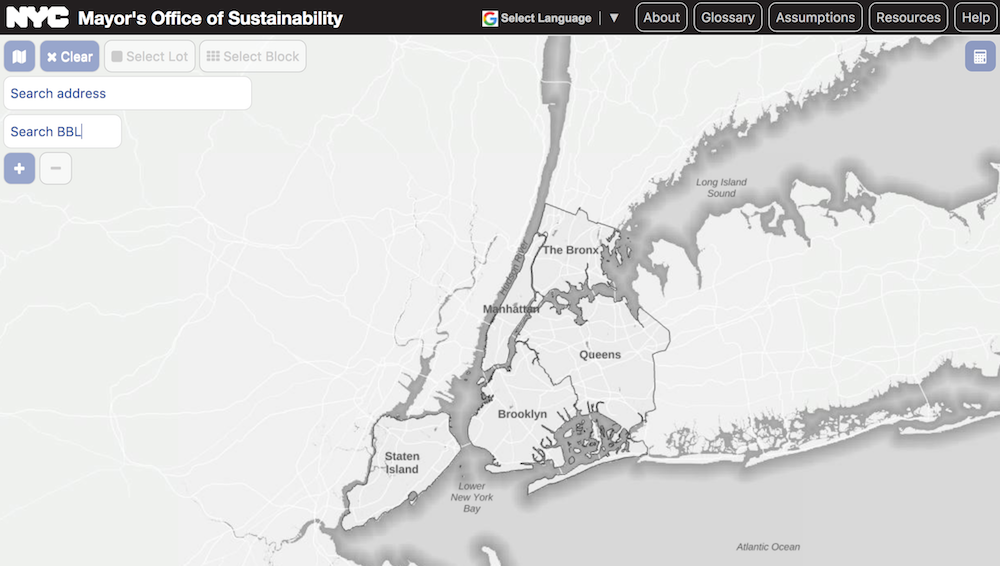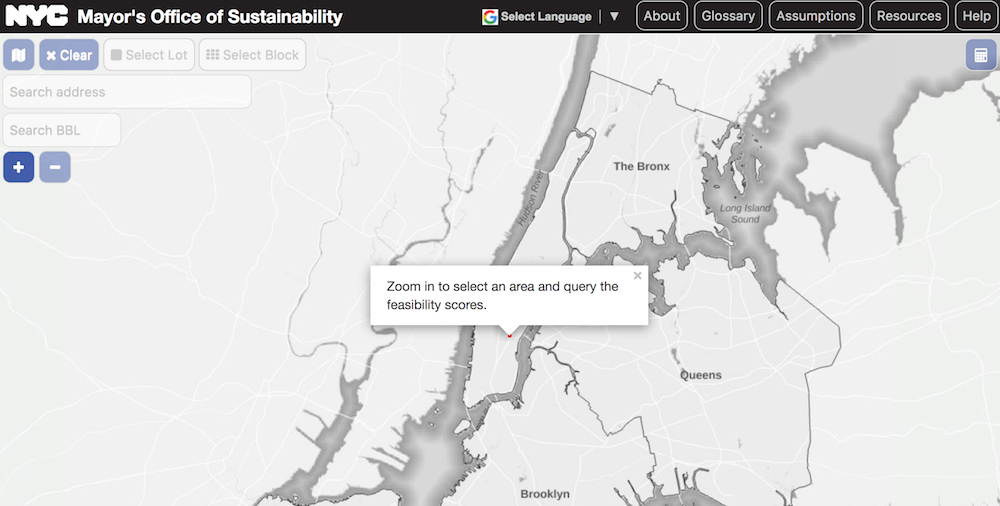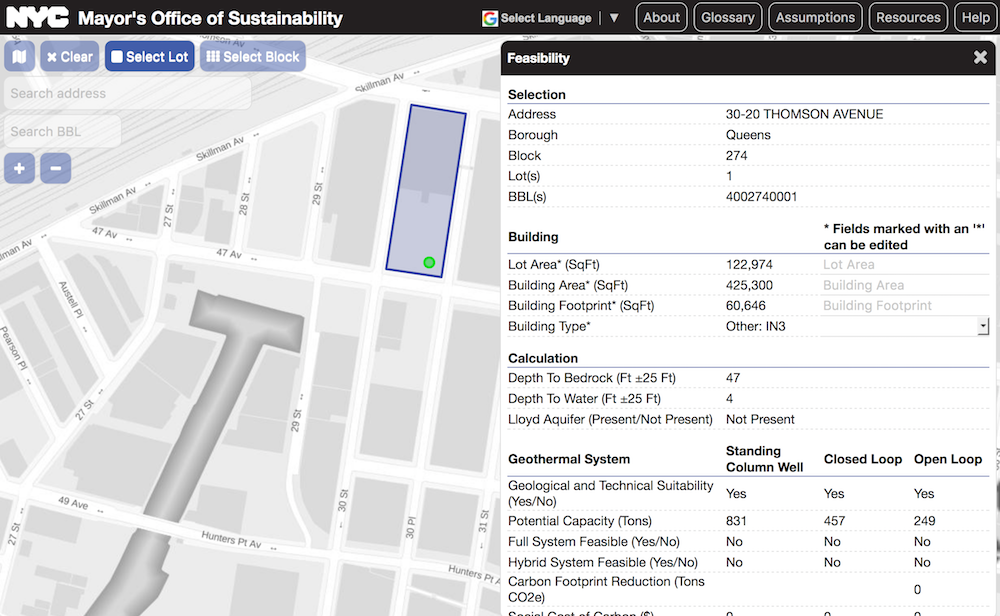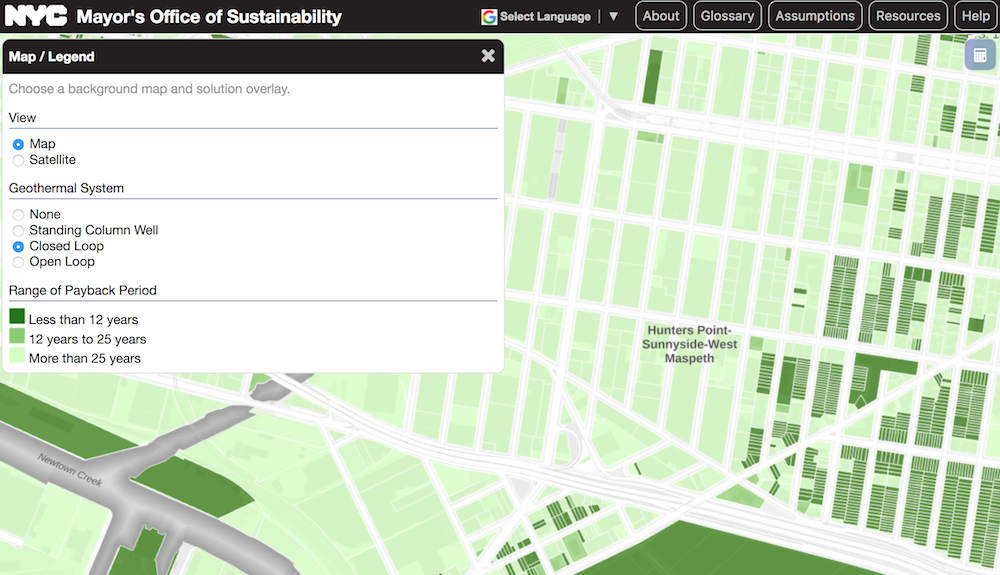Feasibility
| Selection | |||
|---|---|---|---|
| Address | {{ calculation_table.Address }} | ||
| Borough | {{ calculation_table.borough }} | ||
| Block | {{ calculation_table.block }} | ||
| Lot(s) | |||
| BBL(s) | |||
| Building** | * Fields marked with an '*' can be edited | ||
| Lot Area* (SqFt) | {{ calculation_table.LotAreaGIS | round }} | ||
| Building Area* (SqFt) | {{ calculation_table.BldgArea | round }} | ||
| Building Footprint* (SqFt) | {{ calculation_table.FootprSqFt | round }} | ||
| Building Type* | |||
| Calculation | |||
| Depth To Bedrock (Ft ±25 Ft) | {{ calculation_table.DTR | round }} | ||
| Depth To Water (Ft ±25 Ft) | {{ calculation_table.DTW | round | dtw(calculation_table.borough) }} | ||
| Lloyd Aquifer (Present/Not Present) | {{ calculation_table.DTL | present }} | ||
| Geothermal System | Standing Column Well | Closed Loop | Open Loop*** |
| Geological and Technical Suitability (Yes/No) | {{ calculation_table.Feas_DTR | geo_feas_scw(calculation_table.borough, calculation_table.Feas_DTW) | yesno }} | {{ calculation_table.Feas_CL | yesno }} | {{ calculation_table.FeasTechOL | geo_feas_ol(calculation_table) | yesno }} |
| Potential Capacity (Tons) | {{ calculation_table.PotCapSCW | tons | round }} | {{ calculation_table.PotCapCL | tons | round }} | {{ calculation_table.PotCapOL | tons | round }} |
| Full System Feasible (Yes/No) | {{ calculation_table.FeasFulSCW | yesno }} | {{ calculation_table.FeasFulCL | yesno }} | {{ calculation_table.FeasFulOL | yesno }} |
| Hybrid System Feasible (Yes/No) | {{ calculation_table.FeasHybSCW | yesno }} | {{ calculation_table.FeasHybCL | yesno }} | {{ calculation_table.FeasHybOL | yesno }} |
| Carbon Footprint Reduction (Tons CO2e) | {{ calculation_table.CFtpRedSCW | round }} | {{ calculation_table.CFtpRedCL | round }} | {{ calculation_table.CFtpRedOL | round }} |
| Annual Cost of Carbon ($) | {{ calculation_table.InstRedSCW | round }} | {{ calculation_table.InstRedCL | round }} | {{ calculation_table.InstRedOL | round }} |
| Annual Potential Savings with Geothermal System ($) | {{ calculation_table.SavGeoSCW | round }} | {{ calculation_table.SavGeoCL | round }} | {{ calculation_table.SavGeoOL | round }} |
| Projected Incremental Payback with Carbon Credit (Years) | {{ calculation_table.IncrPaySCW | round }} | {{ calculation_table.IncrPayCL | round }} | {{ calculation_table.IncrPayOL | round }} |
| Projected Incremental Payback without Carbon Credit (Years) | {{ calculation_table.SimPaySCW | round }} | {{ calculation_table.SimPayCL | round }} | {{ calculation_table.SimPayOL | round }} |
NOTE: The City's critical infrastructure, such as water tunnels, shafts, or appurtenant facilities are regulated by the New York City Department of Environmental Protection ("DEP"). DEP is in the process of promulgating rules to require that any boring, drilling or excavation to a depth of 50 feet in the borough of the Bronx or north of 135th Street in the borough of Manhattan or to a depth of 100 feet in any other location / borough in New York City first be reported to DEP. Please send written notification of intention to drill or excavate to: Chief of Site Connection and Plan Review, Bureau of Water and Sewer Operations, 9605 Horace Harding Expy, 3rd Floor, Flushing, NY 11368-4100
Furthermore, sites that have contaminated land, are archeologically significant, and/or are located in protected marshland should not move forward with a full feasibility study due to an increased cost.
**: The override calculation assumes new construction with optimal building location to maximize geothermal capacity. In cases of renovation or re-purposing of an existing building, the calculation may over-estimate capacity.
***: For Open Loop systems in the Bronx and Manhattan, the information available from USGS is insufficient.
Geothermal Pre-feasibility Tool Glossary Methodology and Assumptions Resources Help
Welcome to the New York City Geothermal Pre-feasibility Tool. Use this tool to identify areas where ground source, or geothermal heat pump systems may be an option for retrofitting buildings' heating and cooling systems. View instructions for using this tool on our Help page.
In One New York: The Plan for a Strong and Just City, the City committed to reducing greenhouse gas (GHG) emissions 80% by 2050. Reducing emissions in buildings, the largest source of GHG emissions in New York City, is key to reaching this goal. Geothermal heat pump systems are a promising way to reduce emissions from buildings and tap into a cleaner future grid.
Success of geothermal heat pump systems is dependent on a number of key variables, so building owners should still conduct a full feasibility study before installing them.
This tool was brought to you by the New York City Mayor’s Office of Climate & Environmental Justice and the New York City Department of Design and Construction, pursuant to New York City Local Law 6 of 2016.
Definitions were drawn from Department of Design and Construction's Geothermal Heat Pump Manual.
- Closed loop system
- Type of geothermal heat pump system that circulates water with an antifreeze solution in a network of closed piping installed in the group.
- Coefficient of performance
- Ratio of the heat extracted to the energy consumed in the process.
- Ground coupling
- Arrangement of piping and fluid handling equipment designed to exchange heat with the earth's interior.
- Geothermal (ground source) heat pumps
- Heating and cooling devices that take advantage of the relatively constant temperature of the earth's interior, using it as a source or sink for heat. When cooling, heat is extracted from the building and dissipated into the earth; when heating, heat is extracted from the earth and pumped into the space.
- Ground thermal capacity
- Based on geological conditions, the thermal energy available from the lot. The capacity varies depending on the system utilized (open loop, closed loop, or standing column well).
- Heat Exchangers
- Device for transferring thermal energy from one fluid to another.
- Heat pump
- Device used for heating and cooling, which operates by moving heat from a cooler to a warmer location and vice versa, by extracting heat from the air, water, or earth.
- Heating, ventilation and air conditioning (HVAC)
- Hybrid systems
- A system which uses a condensing boiler and/or a cooling tower to supplement the geothermal system
- Open loop system
- Type of geothermal heat pump system that uses ground water pumped from a supply well to transfer heat and returns the water to the ground through diffusion wells.
- Simple payback period
- The period of time required to recoup the funds expended in an investment. The calculation is determined by the initial cost divided by the annual savings, and is not a full life cycle cost analysis.
- Standing column well system
- Type of geothermal heat pump system that also uses ground water, but relies on smaller amounts inside a very deep well to exchange heat with the surrounding bedrock.
The Geothermal Pre-screening Feasibility tool assesses both technical and economic feasibility to make recommendations. The methodology and associated assumptions used to determine feasibility are described below. Words in bold can be found in the Glossary page.
Technical feasibility
Technical feasibility is dependent on a lot's geological and hydrogeological properties, the ground thermal capacity for the geothermal system, and the building's heating and cooling needs.
We analyzed geological and hydrogeological data sourced from the U.S. Geological Survey to screen where in New York City the three types of geothermal ground source heat pump systems (closed loop, open loop, and standing column well) were viable, based on depth to bedrock and depth to groundwater data.
Assessing thermal capacity
We determined ground thermal capacity, or the thermal energy available for use through the application of each system, for each building lot where geological and hydrogeological conditions were favorable. This process included the following steps:
- Developed unit ground thermal capacities for the three main types of geothermal heat pump systems (standing column wells, closed loop, and open loop) using hydrogeological and geological mapping data from the U.S. Geological Survey. The system for determining capacities for each of the systems is included in the full report.
- Calculated the area available for the installation of geothermal systems for each building lot by using available building footprints and lot data, including individual block and lot size, and building footprint and square footage data from Primary Land Use Tax Lot Output.
- Using the unit ground thermal capacity and available land area calculated from 1 and 2, calculated the estimated thermal capacity for the three systems for all building lots in New York City.
Assessing outdoor areas
Geothermal systems are feasible if there is sufficient outdoor area to install the wells, and therefore thermal capacity to meet or exceed the building's peak and annual heating and cooling loads. We assessed whether outdoor area was sufficient using the following steps:
- Developed estimates of building annual heating and cooling loads based on building size, type, and age.
- Compared ground thermal capacity with building requirements to determine if sufficient capacity is available, and if annual heating/cooling loads are sufficiently balanced. To maintain optimal system performance over an extended life cycle, it is essential that the heating and cooling loads off-set each other to maintain constant sub-surface temperatures on a year-to-year basis.
- Evaluated the potential of hybrid systems to achieve balance if heating and cooling loads are not sufficiently similar.
Economic feasibility
After deeming sites to be technically feasible for the installation of a geothermal system, those sites were evaluated for economic feasibility using the following assumptions:
- Assumed the building was planning a full heating/cooling system upgrade.
- Assumed typical heating and cooling systems based on current standards and codes. (These building baseline systems are considered representative of typical buildings in New York City.)
- Assumed the building baselines were developed to estimate energy consumption and installation costs for standard systems, and applied to all buildings.
- Assumed energy consumption and installation costs were developed and applied to all buildings where these systems were feasible.
- Price comparisons were completed based on energy savings with the geothermal system, comparative maintenance costs, a carbon credit as defined within Local Law 6 of 2016, and anticipated installation costs.
- Comparative incremental simple payback periods based on the calculations and assumptions described above were determined for replacing with geothermal versus typical systems. For City facilities, a general recommendation was provided based on these findings.
For more information, please refer to the full report.
Learn more about the Mayor's Office of Sustainability.
Learn more about the New York City Department of Design and Construction.
Read the New York City's Roadmap to 80 x 50 to learn more about the City's integrated analysis to reduce New York City's greenhouse gas emissions 80 percent by 2050 (80 x 50).
Read the TWG's final Report to learn more about the Buildings Technical Working Group (TWG) and the comprehensive analysis on the buildings sector that is crucial in reaching 80 x 50.
Read more about One New York: The Plan for a Strong and Just New York (OneNYC), Mayor Bill de Blasio's comprehensive sustainability plan, which also incorporates growth, equity, and resiliency.
View the DDC Geothermal Heat Pump Manual to learn more about the geothermal heat pump systems in this tool (open loop, closed loop, and standing column wells) and a guide on how to install a geothermal system.
Geothermal Systems and their Application in New York City, February 2015.
Read the Renewable Heating and Cooling Policy Framework: Options to Advance Industry Growth and Markets in New York to start unlocking the potential for renewable heating and cooling technologies to meet societal and customer benefits. This renewable heating and cooling (RH&C) Policy Framework considers a set of policies that can support the growth of the RH&C market in New York State. The Policy Framework is structured around consideration of three major pillars: (i) reducing technology costs and lowering barriers such as supply chain, customer awareness and finance barriers; (ii) RH&C mandates that could drive demand for RH&C in new construction and major renovations; and (iii) incentives that improve project cost effectiveness.
Read the Geothermal Heating and Cooling: Design of Ground-Source Heat Pump Systems, a complete revision of Ground-Source Heat Pumps: Design of Geothermal Systems for Commercial and Institutional Buildings, which is a reference for nonresidential ground-source heat pump (GSHP) installations. This new work takes advantage of the many lessons learned since the time of the original publication, when GSHPs were primarily residential applications.
To search feasibility information for a specific property, enter either a building's address or borough-block-lot (BBL) and hit "Enter" on your keyboard.

You can also select a property by clicking on the map. To zoom in on the map, use your mouse or your + and – buttons.

Once you select a lot, a window on the right half of the screen will display information about the lot's buildings and their feasibility for geothermal systems.

To view feasibility levels of specify types of geothermal systems, click on the map icon on the top left corner of the screen and select a system type.
